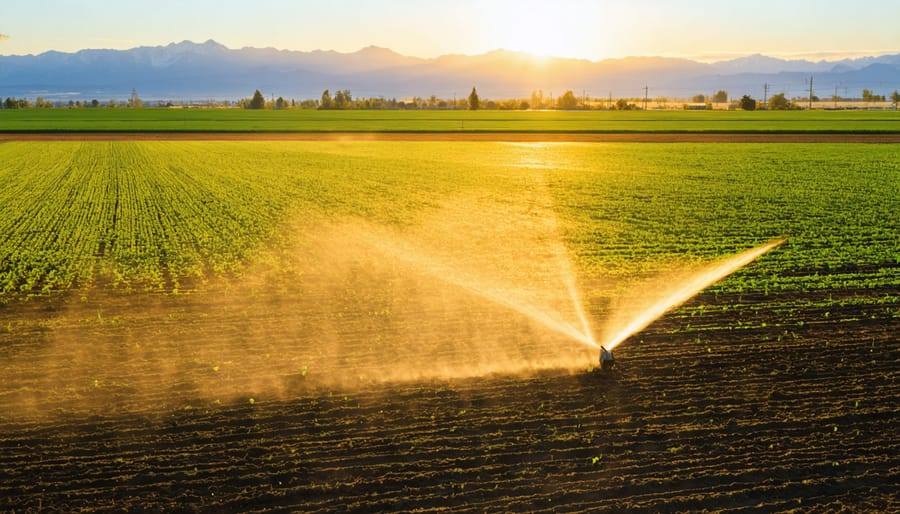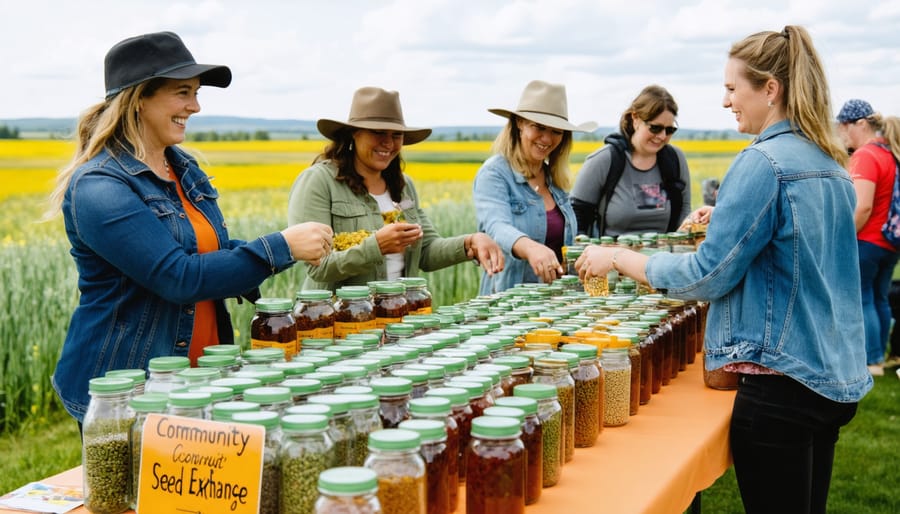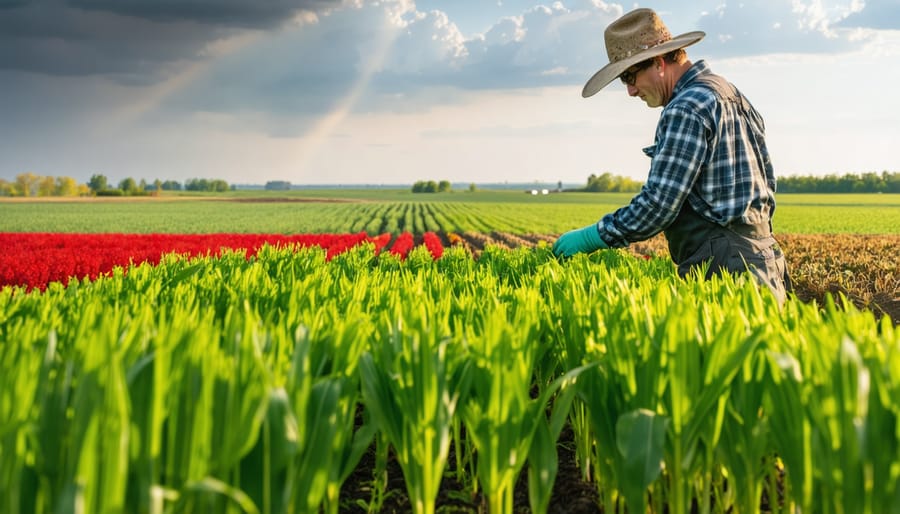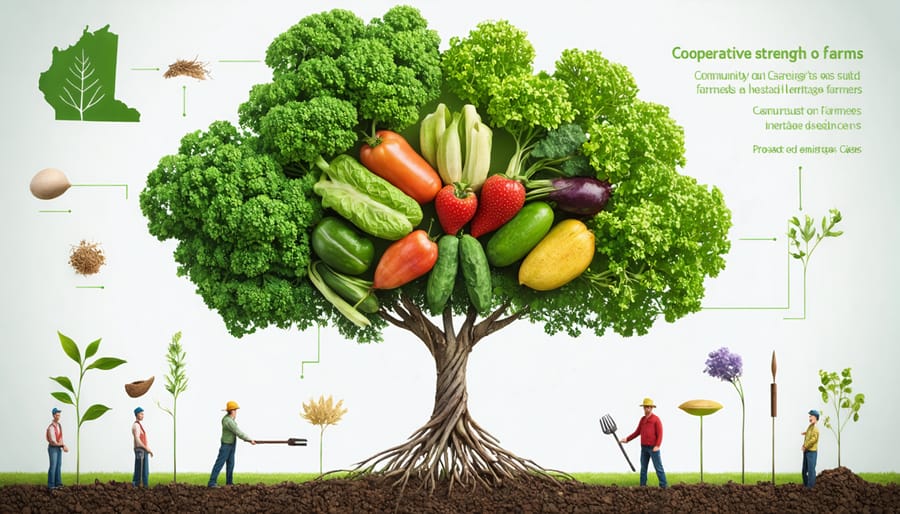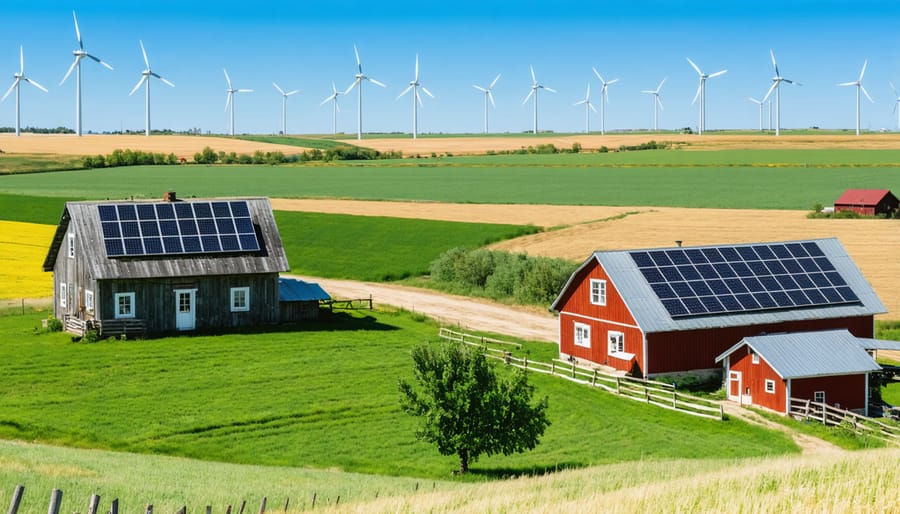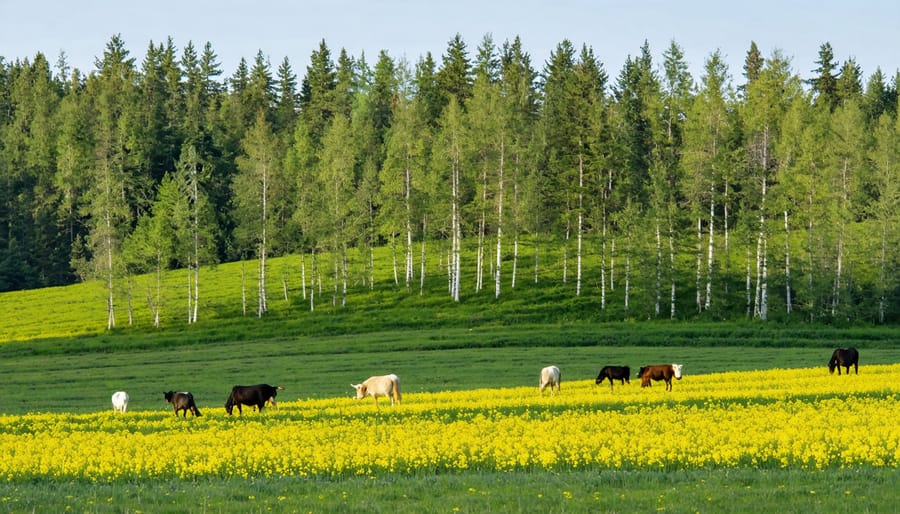Canadian dairy farming stands at the forefront of agricultural innovation, combining centuries-old traditions with cutting-edge sustainable practices. Across the nation’s 10,000+ dairy farms, predominantly family-owned operations, farmers are revolutionizing the industry through organic initiatives and technological advancement. From Quebec’s rich dairy belt to Alberta’s expanding operations, Canadian dairy producers maintain some of the world’s highest standards for milk quality and animal welfare.
The sector’s unique supply management system has created a stable foundation for sustainable growth, enabling farmers to invest confidently in organic transitions and innovative practices. Today’s Canadian dairy farms increasingly embrace robotics, precision agriculture, and regenerative farming methods while maintaining the industry’s commitment to producing high-quality, sustainable dairy products.
This transformation comes at a crucial time, as consumer demand for organic dairy products continues to surge, presenting both challenges and opportunities for Canadian farmers. With strict federal regulations ensuring product quality and animal welfare, Canadian dairy farms are uniquely positioned to lead North America’s transition toward more sustainable and organic dairy production methods.
Through strategic investments in technology, environmental stewardship, and animal care, Canadian dairy farming exemplifies how traditional agricultural practices can evolve to meet modern sustainability demands while maintaining economic viability.
The Path to Organic Dairy Certification in Canada
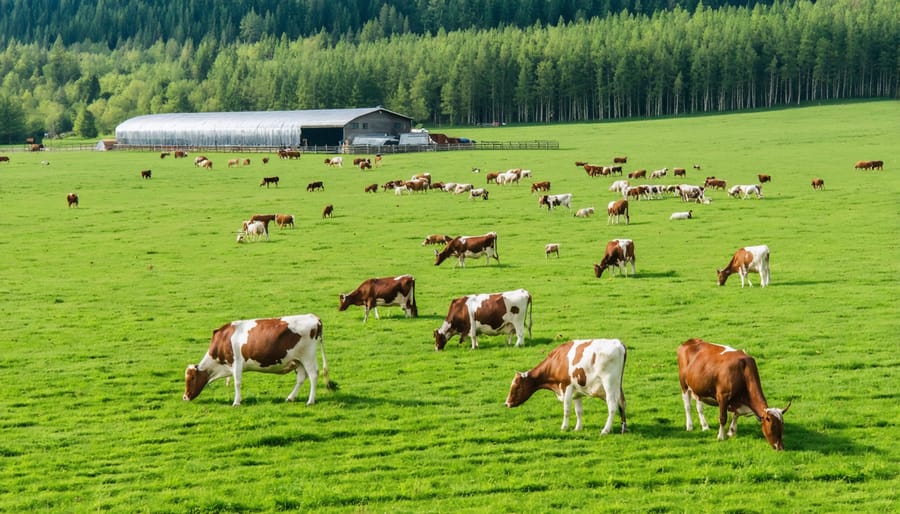
Key Certification Standards
Canadian dairy farmers pursuing organic certification must adhere to strict organic certification standards established by the Canadian Organic Regime (COR). These requirements include a mandatory 12-month transition period for dairy herds, during which time animals must be managed organically and fed 100% organic feed.
Key certification requirements include providing cattle with access to pasture during the grazing season, maintaining a minimum of 30% dry matter intake from grazing, and ensuring at least 6 square metres of outdoor exercise area per adult animal. Housing facilities must offer comfortable bedding and natural lighting, with tie-stall housing permitted only during winter months.
Feed must be certified organic, with no animal by-products or prohibited substances. Calves must receive organic whole milk for a minimum of three months, and preventive healthcare practices should focus on natural methods. Antibiotic use is strictly regulated, with treated animals requiring double the standard withdrawal period before their milk can be sold as organic.
Record-keeping is essential, documenting feed sources, health treatments, and grazing schedules. Annual inspections verify compliance with these standards, ensuring the integrity of organic dairy production.
Transition Timeline and Support
The transition to certified dairy farming typically takes 12-15 months in Canada, with support available at every step. Farmers begin by connecting with a certification body and completing an initial farm assessment. During months 1-3, producers focus on documentation preparation and developing their organic system plan, including feed sourcing strategies and animal health protocols.
From months 4-12, farms implement required changes while maintaining detailed records. This period involves transitioning feed production to organic methods, establishing buffer zones, and adapting herd health management practices. Provincial organizations like Alberta Milk offer transition planning assistance and mentorship programs connecting new organic producers with experienced farmers.
Financial support is available through various channels, including the Canadian Agricultural Partnership, which provides funding for certification costs and infrastructure improvements. Technical assistance is accessible through provincial agricultural extension services, offering soil testing, workshops, and one-on-one consulting.
Many regions host organic dairy farming networks where producers share experiences and resources. These communities prove invaluable during the transition period, providing practical solutions and emotional support. Regular check-ins with certification bodies ensure farms stay on track throughout the process.
Sustainable Practices in Organic Dairy Operations
Pasture Management and Animal Welfare
Canadian dairy farmers prioritize both pasture management and animal welfare requirements to maintain healthy herds and sustainable operations. During the grazing season, which typically runs from May to October in most regions, farmers implement rotational grazing systems to ensure optimal pasture utilization and recovery periods for vegetation.
Best practices include dividing pastures into paddocks, with herds moved every 1-3 days depending on grass growth and herd size. This approach helps prevent overgrazing while promoting soil health and biodiversity. Many Alberta dairy farmers maintain approximately 1-2 hectares of pasture per cow to ensure adequate grazing throughout the season.
Animal care standards focus on providing comfortable living conditions, proper nutrition, and preventive healthcare. Dairy cows have access to clean water, shade structures during hot weather, and wind barriers during cooler months. Regular veterinary check-ups and hoof trimming are essential components of health management protocols.
Modern dairy barns feature rubber mattresses or sand bedding for cow comfort, ventilation systems to maintain optimal temperatures, and automated brushes that allow cows to groom themselves naturally. These facilities are designed to accommodate natural behaviors while protecting animals from extreme weather conditions.
Local dairy farmers often collaborate through mentorship programs to share successful pasture management strategies and animal care practices, fostering a community-focused approach to continuous improvement in herd management.
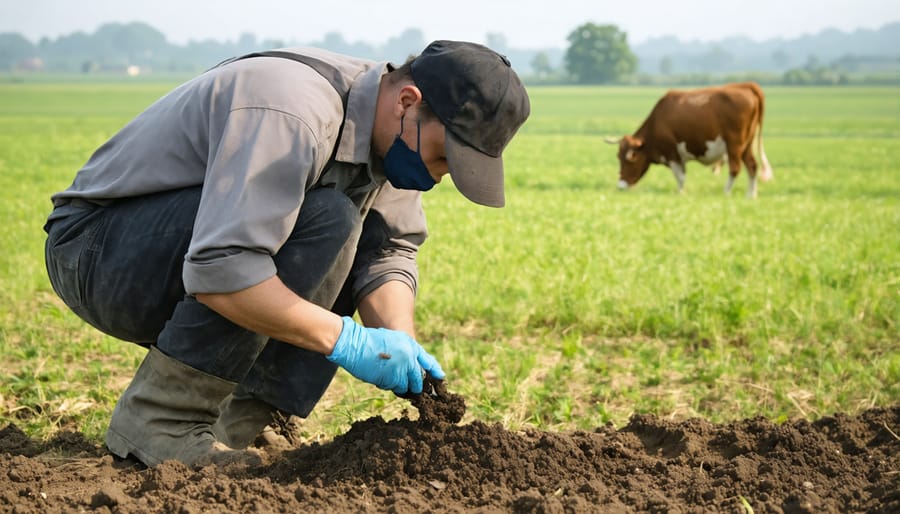
Soil Health and Carbon Sequestration
Canadian dairy farmers are increasingly recognizing the vital connection between soil health and sustainable farming practices. Through implementing targeted soil conservation practices, dairy operations across Alberta and beyond are not only improving their land’s productivity but also contributing to climate change mitigation through carbon sequestration.
Recent studies from Agriculture Canada show that dairy farms implementing regenerative practices can sequester up to 2 tonnes of carbon per hectare annually. These practices include rotational grazing, cover cropping, and reducing tillage intensity. By maintaining diverse forage species in pastures and implementing strategic manure management, farmers are building organic matter while improving soil structure.
Local success stories demonstrate the effectiveness of these approaches. The Anderson Family Farm in Red Deer County increased their soil organic matter by 2% over five years through integrated pasture management and strategic crop rotation. This improvement led to better water retention, reduced fertilizer needs, and more resilient forage production during dry periods.
Soil testing programs across Alberta reveal that dairy farms practicing these methods typically show higher levels of biological activity and improved nutrient cycling. This translates to better feed quality for dairy herds and reduced input costs. Many farmers report that healthier soils have helped them maintain production levels even during challenging weather conditions, proving that environmental stewardship and operational efficiency can work hand in hand.
Waste Management Solutions
Modern Canadian dairy farms are leading the way in sustainable waste management through innovative recycling and handling systems. Many Alberta dairy operations now utilize advanced manure management techniques that transform waste into valuable resources for the farm and surrounding community.
A growing number of farms have implemented anaerobic digesters, which convert manure into biogas for electricity generation and high-quality fertilizer. This system not only reduces greenhouse gas emissions but also provides an additional revenue stream through power generation. The resulting digestate serves as an excellent soil amendment, reducing the need for synthetic fertilizers.
Bedding recycling systems have become increasingly popular, with many farms processing used bedding material through specialized equipment to create clean, comfortable bedding for their herds. This practice significantly reduces waste while cutting operational costs.
Water recycling systems are another cornerstone of modern dairy waste management. Advanced filtration systems clean and recycle water used in the milking parlour and barn cleaning, reducing fresh water consumption by up to 50%. Many farms also collect and filter rainwater for various farm operations.
Sand separation systems allow farms using sand bedding to recover and reuse up to 95% of their bedding material. The separated organic matter is then composted and used as fertilizer, creating a closed-loop system that minimizes waste and maximizes resource efficiency.
These solutions not only benefit the environment but also improve farm profitability through reduced input costs and potential revenue from by-products.
Economic Viability and Market Growth
Market Demand and Price Premiums
The Canadian dairy market continues to demonstrate strong consumer demand for organic and sustainably produced dairy products, with premium prices reflecting this trend. Recent market analyses show that organic dairy products command a premium of 20-30% over conventional products, providing significant revenue opportunities for farmers who transition to organic practices.
In Alberta specifically, local organic dairy farmers report receiving up to $0.15 more per litre compared to conventional milk prices, while also benefiting from more stable long-term contracts. This price stability helps offset the higher production costs associated with organic farming methods and provides a more predictable income stream.
Consumer awareness and demand for organic dairy products have grown steadily over the past decade, with year-over-year growth averaging 6% across Canada. Market research indicates that consumers are increasingly willing to pay premium prices for dairy products that align with their values regarding animal welfare, environmental sustainability, and health considerations.
Several successful dairy operations in Alberta have reported that their transition to organic practices has resulted in improved profit margins, despite initial investment costs. These farmers emphasize that while organic certification requires significant upfront commitment, the long-term financial benefits, including reduced veterinary costs and higher market prices, have made the transition worthwhile.
The growing number of processor partnerships and direct-to-consumer sales channels has also created additional revenue streams for organic dairy farmers, further enhancing the economic viability of organic operations.
Government Support Programs
The Canadian government offers substantial support to dairy farmers through various programs designed to enhance sustainability and operational efficiency. The Canadian Dairy Commission (CDC) provides essential price support and market stabilization, while provincial initiatives offer targeted assistance for infrastructure improvements and technology adoption.
A key program is the Dairy Farm Investment Program, which provides up to $250,000 per farm for modernization projects. This includes funding for automated milking systems, feeding equipment, and barn renovations. The Agricultural Clean Technology Program specifically supports environmental improvements, offering grants for renewable energy installations and waste management systems.
For those interested in transitioning to organic production, several organic farming grants are available through federal and provincial channels. The Canadian Agricultural Partnership (CAP) framework delivers significant funding opportunities, with matching contributions of up to 50% for eligible projects.
Alberta dairy farmers can access additional provincial support through Growing Forward 3, which offers specialized programs for young farmers and innovation initiatives. The Environmental Stewardship and Climate Change Producer Program provides funding specifically for sustainable farming practices, including up to $70,000 for qualified projects.
These programs often require detailed business plans and environmental assessments. Local agricultural offices provide guidance through the application process, ensuring farmers can maximize their funding opportunities while meeting program requirements.
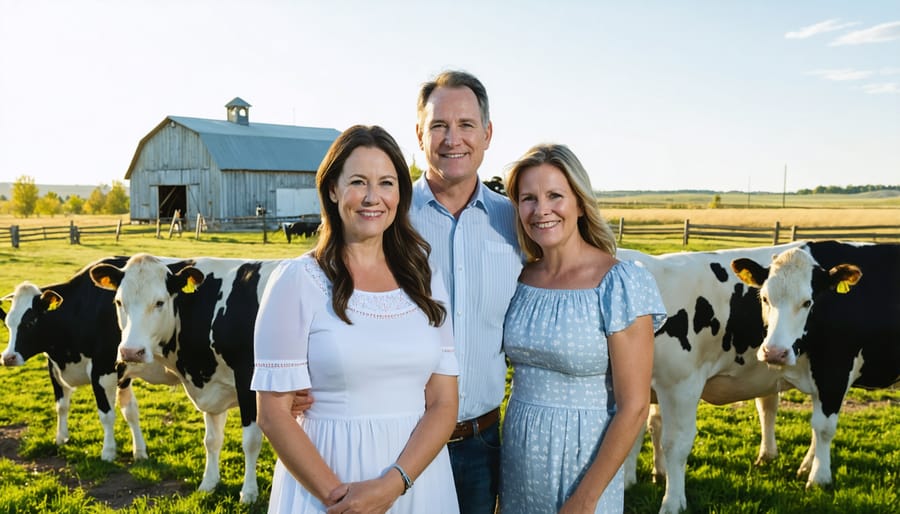
Alberta Success Story: The Matthews Family Farm
Located just outside of Red Deer, the Matthews Family Farm stands as a shining example of successful organic dairy farming in Alberta. John and Sarah Matthews, third-generation farmers, made the bold decision to transition their conventional dairy operation to organic in 2012, and they haven’t looked back since.
The Matthews manage a herd of 85 Holstein-Jersey cross cattle on their 240-hectare property, where they grow their own organic feed and implement rotational grazing practices. Their journey to organic certification took three years of careful planning and implementation, during which they focused on soil health improvement and establishing sustainable pasture management systems.
“The transition wasn’t without its challenges,” Sarah Matthews explains, “but the support from the organic farming community and the increasing demand for organic dairy products made it worthwhile.” The family reports that their milk production, while initially lower during the transition period, has stabilized at 28 litres per cow per day, with significantly lower veterinary costs than their conventional farming days.
Key to their success has been their innovative approach to herd health management. The Matthews utilize a combination of herbal remedies and preventative care practices, maintaining herd health without relying on antibiotics. Their commitment to animal welfare has resulted in longer-living cows with improved fertility rates.
The farm’s financial performance has also been impressive. Despite higher production costs, their premium organic milk prices and reduced input costs have led to a 30% increase in net farm income compared to their conventional operation. They’ve also developed additional revenue streams by producing organic cheese and yogurt in their on-farm processing facility.
The Matthews regularly host farm tours and workshops, sharing their knowledge with other farmers considering the organic transition. “We believe in the importance of building a strong organic farming community in Alberta,” John Matthews says. “When one farm succeeds, we all succeed.”
The future of organic dairy farming in Canada shows promising growth, particularly as consumers increasingly demand sustainable and ethically produced dairy products. Our examination of current trends and practices reveals that organic dairy operations, while requiring significant initial investment and dedication, offer viable long-term opportunities for Canadian farmers looking to diversify their operations and increase profitability.
The transition to organic practices represents more than just a change in production methods – it’s a commitment to environmental stewardship and animal welfare that resonates strongly with modern consumers. Successful organic dairy farmers across Alberta and other provinces have demonstrated that combining traditional farming wisdom with innovative sustainable practices can create resilient and profitable operations.
Looking ahead, the sector faces both challenges and opportunities. Climate change adaptation, evolving regulatory requirements, and market fluctuations will continue to shape the industry. However, strong support systems, including mentorship programs, government initiatives, and industry associations, provide valuable resources for farmers considering or maintaining organic certification.
The key to success lies in careful planning, continuous education, and community engagement. As more farmers share their experiences and best practices, the organic dairy sector becomes increasingly accessible to newcomers. With growing market demand, technological advancements in sustainable farming, and strengthening support networks, organic dairy farming in Canada is well-positioned for continued growth and success in the coming years.


